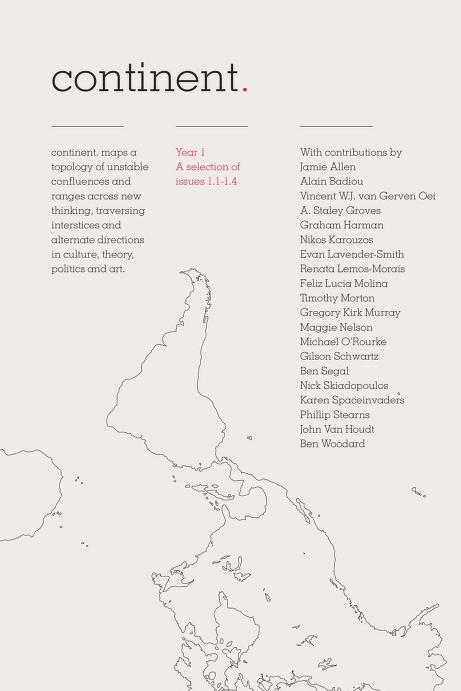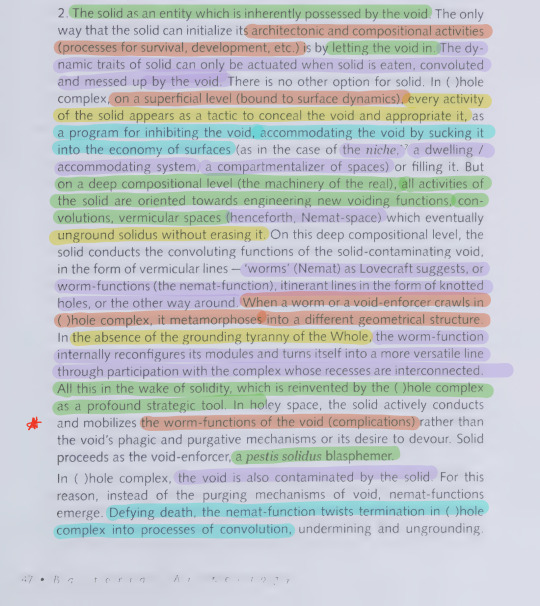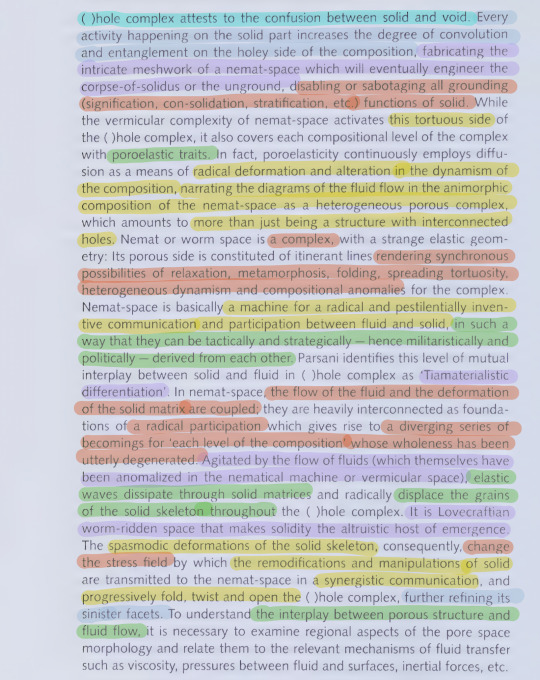#cyclonopedia
Explore tagged Tumblr posts
Text
Im an open book but the book is Cyclonopedia
4 notes
·
View notes
Text
i love becoming known in my english class as the guy whos always reading some weird ass obscure pirated horror book
#my teacher was like “nico what ru reading 2day? do i even want 2 know??”#and i giggled & kicked my feet a little before proceeding to explain the plot of#cyclonopedia#anyways great book i totally recommend it if u like sci-fi or like speculative biology or anything#good stuff
1 note
·
View note
Text


Around 200 million years ago, at the height of the war, some of the insectform war machines laid eggs. About 1000 years ago, in the cliffs of Utah, they hatched. What have they been up to since? Cyclonopedia by Reza Negarastani is one of my favorite books.
1 note
·
View note
Text
ideal picture of me
completely naked and pale and hairless (in a neurotic way) in a pitch black field
looking very transgender, but you can’t really tell what gender is in this context
covered in blood from the neck down but not visibly injured
flash of the camera captures me only from the bridge of the nose down, my eyes are completely obscured, you can only really see my smile
I’m smiling the biggest grin you’ve ever seen, standing with one armed raised, beckoning you to join
#yeah I was raised by actually weird weird Twitter#when SCP and Nick Land and Cyclonopedia felt more real than anything else#Yes I still find comfort in the weird and eerie#Yes I daydream about being a devil or trickster figure#No I don’t know how to be normal about wanting to be a girl
7 notes
·
View notes
Text

The Black Flame or: subterranean blood worship
inspired by Cyclonopedia by Reza Negarestani
In earth’s hallowed subterranean womb confined, Where shadows breathe and darkness ever reigns, A liquid flame ignites the space entwined, A sentient force within blackened veins. From ancient soil doth black gold softly seep, A whisper silent, cosmic cry forlorn, Through fractured stone its essence dark doth creep, A tellurian pulse ‘neath sky is born.
The East, a vortex deep and tempest-torn, A stage where earth and man in conflict stand, Where ancient myths in anger are reborn, And weeping springs anew in desert sand. Oil, blood of earth in dolorous descent, A weapon forged within nature’s core, The congealed biomass of epochs lent, To create heat and energy, evermore.
Petroleum, thou dark and subtle foe, In complicity we bind our fate, To forces deep beneath the sky doth grow, In shadows of a timeless state. Through warlike engines and through armor’d might, The black flame fuels unending, ceaseless strife, A dance of shadows in the darkened night, Entwined with human soul and mortal life.
The blackening, a world by fire transformed, By liquid’s unyielding grip enthralled, In myth and mind its presence has stormed, Through history’s veins it drips and calls. O worshippers of the blackened flame, In complicity we take our part, Bound to the liquid’s ancient claim, Its darkness etched upon our heart.
As tellurian whispers rise and fall, And subterranean plots do yet unfold, We seek the truth ‘neath lies that we enthrall, In oil’s embrace, a tale is told. In blackened fields, where shadows darkly bloom, And myths of old find life in form anew, We worship at the earth’s most ancient tomb, The liquid flame, both old and true.
Through punctured earth, the otherworldlies creep, Dimensional gates where shadows breathe, Our ignorance, a gift to depths that seep, In oil’s dark thrall, we blindly weave. A mirror to the sun’s consuming fire, The earth rebels in shadow’s cold embrace, An apocalyptic end, our dark desire, In blackened veins, we find our fateful place.
-8/2/24
#poetry#original poem#poems on tumblr#poems and poetry#poem#poetic#spirituality#occult#oil#ai art#ai artwork#digitalart#chatgpt#spilled writing#spilled ink#spilled thoughts#spilled words#spilled poetry#poetblr#poet blog#poets on tumblr#writers and poets#poems#middle east#iran#iraq#iraq war#hezbollah#hamas#israel
6 notes
·
View notes
Text
Finally, even in the absence of desert-nomadism, oil turns Time toward apocalyptic blasphemies. ... oil, with its poromechanical zones of emergence in economy, geopolitics and culture, mocks the Divine chronological time with the utmost irony and obscenity.
Holistic political, religious and military readings - based on the logics of whole, its parts and the environment - sacrifice the autonomy of their object in favour of their environments or their global wholes.
Theology is in general constantly obsessed with plugging holes, covering cracks and fissures in reasoning of and about the Divine. Thus, it forms lacunae of imperfection by which the corpus of theology can always be mobilised against itself, turning against itself and biting back its body. To do rigorous theology is to perforate the Divine's corpus with heresies.
I do not look at monotheistic religions as Secret-o-al-Mostaghim (the straight path), nor do I curse them as ghouls of repression. I simply see them as generous mothers pregnant with their minorities - thousands, millions of them; a female scorpion devoured by its own children, ripped apart from the belly. This is what Ibn Maymun taught us, the minority holocaust. (H. Parsani)
Reza Negarestani, Cyclonopedia
6 notes
·
View notes
Text
“(…) because playing with memory (i.e. inventing lines of iteration through memory other than mere remembering functions) sorcerously reinvents events not as localizable beings but as deathless (in the sense of demonic restlessness) and inexhaustible germ-lines. Playing with memory, beyond the legitimate activity of remembering, enmeshes memory as a playground of agitated activities in the past which break the organizational consistency of the past in regard to present and future. The past as a static chronologic horizon intrinsically tends to sedentarize all types of activities in itself, or to make itself the stabilizing ground of activities in present or future: The past belongs to the Divine and tradition.”
-Cyclonopedia: Complicity with Anonymous Materials (2008, 68), Reza Negarestani
12 notes
·
View notes
Text
It's finally dawning on me that at some point I'm going to have to sit down and read Cyclonopedia (Convergence of interests upon a single point. Inevitable. Inescapable. I passed cyclonopedia's event horizion the Second I started thinking about oil) which is both thrilling, and filling me with dread because I'm already getting the impression that this is going to be like reading the Day of the Jackal again.
5 notes
·
View notes
Text
First book im gonna read for the year is cyclonopedia
5 notes
·
View notes
Photo

https://archive.org/details/b4d68a6d-01fb-48f1-9f64-1fcdaaf1cdfd/mode/2up
Essays, articles, artworks, and documents taken from and inspired by the symposium on Reza Negarestani’s Cyclonopedia: Complicity with Anonymous Materials, which took place in March 2011 at The New School. Hailed by novelists, philosophers, artists, cinematographers, and designers, Cyclonopedia is a key work in the emerging domains of speculative realism and theory-fiction. The text has attracted a wide-ranging and interdisciplinary audience, provoking vital debate around the relationship between philosophy, geopolitics, geophysics, and art. At once a work of speculative theology, a political samizdat, and a philosophic grimoire, Cyclonopedia is a Deleuzo-Lovecraftian middle-eastern Odyssey populated by archeologists, jihadis, oil smugglers, Delta Force officers, heresiarchs, and the corpses of ancient gods. Playing out the book’s own theory of creativity – “a confusion in which no straight line can be traced or drawn between creator and created – original inauthenticity” – this multidimensional collection both faithfully interprets the text and realizes it as a loving, perforated host of fresh heresies. The volume includes an incisive contribution from the author explicating a key figure of the novel: the cyclone.
#speculative fiction#speculative realism#theory-fiction#gilles deleuze#howard phillips lovecraft#philosophy#cultural theory#art#science fiction
17 notes
·
View notes
Text
Started reading Slatsky’s Immeasurable Corpse of Nature (the story itself, in the book of the same name). I like it so far! It reminds me a little bit of Cyclonopedia, although easier to decipher.
I wasn’t expecting a Le Guin reference to be a significant detail of the story, and now I feel like I need to read The Ones Who Walk Away from Omelas.
2 notes
·
View notes
Text


from Cyclonopedia: Complicity with Anonymous Materials by Reza Negarestani, pp. 47-48
«
2. The solid as an entity which is inherently possessed by the void. The only way that the solid can initialize its architectonic and compositional activities (processes for survival, development, etc.) is by letting the void in. The dynamic traits of solid can only be actuated when solid is eaten, convoluted, and messed up by the void. There is no other option for solid. In ( )hole complex, on a superficial level (bound to surface dynamics), every activity of the solid appears as a tactic to conceal the void and appropriate it, as a program for inhibiting the void, accommodating the void by sucking it into the economy of surfaces (as in the case of the niche,¹⁷ a dwelling / accommodating system, a compartmentalizer of spaces) or filling it. But on a deep compositional level (the machinery of the real), all activities of the solid are oriented towards engineering new voiding functions, convolutions, vermicular spaces (henceforth, Nemat-space) which eventually unground solidus without erasing it. On this deep compositional level, the solid conducts the convoluting functions of the solid-contaminating void, in the form of vermicular lines — ‘worms’ (Nemat) as Lovecraft suggests, or worm-functions (the nemat-function), itinerant lines in the form of knotted holes, or the other way around. When a worm or a void-enforcer crawls in ( )hole complex, it metamorphoses into a different geometrical structure. In the absence of the grounding tyranny of the Whole, the worm-function internally reconfigures its modules and turns itself into a more versatile line through participation with the complex whose recesses are interconnected. All this in the wake of solidity, which is reinvented by the ( )hole complex as a profound strategic tool. In holey space, the solid actively conducts and mobilizes the worm-functions of the void (complications) rather than the void’s phagic and purgative mechanisms or its desire to devour. Solid proceeds as the void-enforcer, a pestis solidus blasphemer.
In ( )hole complex, the void is also contaminated by the solid. For this reason, instead of the purging mechanisms of void, nemat-functions emerge. Defying death, the nemat-function twists termination in ( )hole complex into processes of convolution, undermining and ungrounding. ( )hole complex attests to the confusion between solid and void. Every activity happening on the solid part increases the degree of convolution and entanglement on the holey side of the composition, fabricating the intricate meshwork of a nemat-space which will eventually engineer the corpse-of-solidus or the unground, disabling or sabotaging all grounding (signification, con-solidation, stratification, etc.) functions of solid. While the vermicular complexity of nemat-space activates this tortuous side of the ( )hole complex, it also covers each compositional level of the complex with poroelastic traits. In fact, poroelasticity continuously employs diffusion as a means of radical deformation and alteration in the dynamism of the composition, narrating the diagrams of the fluid flow in the animorphic composition of the nemat-space as a heterogeneous porous complex, which amounts to more than just being a structure with interconnected holes. Nemat or worm space is a complex, with a strange elastic geometry: Its porous side is constituted of itinerant lines rendering synchronous possibilities of relaxation, metamorphosis, folding, spreading tortuosity, heterogeneous dynamism and compositional anomalies for the complex. Nemat-space is basically a machine for a radical and pestilentially inventive communication and participation between fluid and solid, in such a way that they can be tactically and strategically—hence militaristically and politically—derived from each other. Parsani identifies this level of mutual interplay between solid and fluid in ( )hole complex as “Tiamaterialistic differentiation.” In nemat-space, the flow of the fluid and the deformation of the solid matrix are coupled; they are heavily interconnected as foundations of a radical participation which gives rise to a diverging series of becomings for “each level of the composition” whose wholeness has been utterly degenerated.
Agitated by the flow of fluids (which themselves have been anomalized in the nematical machine or vermicular space), elastic waves dissipate through solid matrices and radically displace the grains of the solid skeleton throughout the ( )hole complex. It is Lovecraftian worm-ridden space that makes solidity the altruistic host of emergence. The spasmodic deformations of the solid skeleton, consequently, change the stress field by which the remodifications and manipulations of solid are transmitted to the nemat-space in a synergistic communication, and progressively fold, twist and open the ( )hole complex, further refining its sinister facets. To understand the interplay between porous structure and fluid flow, it is necessary to examine regional aspects of the pore space morphology and relate them to the relevant mechanisms of fluid transfer such as viscosity, pressures between fluid and surfaces, inertial forces, etc.
¹⁷ The Polish philosopher Roman Witold Ingarden, in his works focused on ontology (written after breaking from Husserl’s phenomenology through a critique of transcendental idealism) expounds on the problem of openness and affordance, suggesting that closure (or modulated /economical openness) is a priority for open systems, and for analyzing niches as power projection zones and inhibitors of unwanted interactions and communications. The openness of the niche protects itself from what makes it open, by opening itself to what makes it closed. Only through such an openness can the existential moments be afforded, so that modes of Being are then able to emerge.
»
0 notes
Text
Doubts 'bout Cyclonopedia: does these mean anything?
Reza Negarestani's most famous book, Cyclonopedia (2008), is a hard one to get through. Far from impossible, though. Even if you're not following its threads closely, the main theme isn't all that missable—not by a long shot.
Perhaps I'm too invested in the book's world to be able to surmise it neatly; perhaps to do so is against its core message(s). If you have read it already, you can skip this paragraph, but if you're reading this post because you're interested in it, just give it a shot. If the preface (named 'incognitum hactenus') doesn't hook you in, maybe leave it for now. Alas, if you'd still like to be given something to chew on, its premise is that the Middle East, as a geopolitical entity, is alive; its petroil is not only sentient but also the lubrificant that gets the deleuzoguattarian Body without Organs all lubbed up and smooth so the chains flying out of these Lament Configurations called war-machines can have a good time channeling us to the Insurrectionary Other.
If you're familiar with SF at all, you'll excuse Cyclonopedia habit of presenting its terminology and lingo first, with explanations later. But you also can have it as a philosophical treatise, and a serious one at that. It has a credible bibliography, and the book's reinterpretations of its source materials are not unprecedented, either. For example, when it says the Middle East is alive, and all that jazz about oil, it is getting that off of a certain Dr. Parsani, so heavily quoted, matter of fact, you'd think he's not real, but a Theory-Fiction fabrication. But that's just not the case.
I absented myself from doing any 'behind the scenes' research on Cyclonopedia, though. At least, for now. I finished it some weeks ago and am currently past the 200-page mark of Fanged Noumena. But it still has its little mysteries, and I still wonder what these Plot Holes are yet successfully withholding from me. And that's what I need help with.
Assuming you have read it, you know Cyclonopedia doesn't tell you everything. Quick example: 'incognitum hactenus' gives the reader two links, but it doesn't tell what they're for. It matters little, nonetheless: one is a time zone converter and the other is a Not Found page (unless you erase part of it so you're directed to a 'Computer Science student web server'?).
But, of course, there's more. There's the '2th 3St', 2 and S being character's names, but still, it doesn't come up again in this equation form, so what's up with that?
Following, I give the ones that really stuck with me along these weeks I thought I put it to rest. Needless to say, this is a cry for help.
I. This footnote:

II. This other footnote, which might be Persian:

III. Also this one:

IV. On page 39 (and the previous one), you see these strings of 'random' bracketed numbers (the footnote talks about PGPs):

V. And finally, there's a footnote on page 37 where someone (Reza?) is at the hotel room 302, bothered by someone (the preface's author) wearing a DFA 1979 shirt. But if we go back to the preface, it is she who is at the 302 room. There, you read:
// SSS ['S' is the same person Reza? is adressing in the 37 footnote] Try to change my room as 302 is really getting to me. There is someone [Reza?] in the window across the way who keeps looking at me.
//
I'm wondering if this is an overlook (it seems that way), or a time-space shenanigans scenario, since the preface gives us this graph:

I'm sure other minor things could also be adressed, and even these ones shouldn't make too much of a difference, if at all, but—at the same time I don't want to sign up a reddit account to ask this, and will therefore shout into the tumblr void—engaging in a community manner with Cyclonopedia, CCRU or CCRU-adjacent material is, probably, the better way to do it and proceed.
1 note
·
View note
Text
"Cyclonopedia" wishes it was a quarter as raw as "The SCUM Manifesto"
0 notes
Text
this isnt a conspiracy theory this is a clickbait video digest of cyclonopedia. which is worse

Desperate to inform everyone on twitter that this is a dragon age subplot
2K notes
·
View notes
